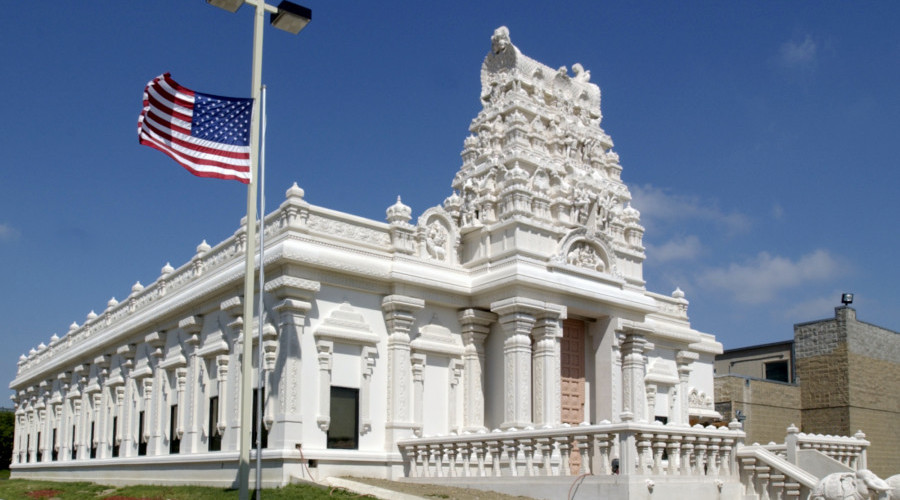If you read between the lines of the vandalized signboard in Winston-Salem, North Carolina, you’ll see more than just 60 bullet holes perforating the blue sans serif lettering that reads ‘Hindu Temple’.
The punctures, though ominous, do little to threaten the place of the Hindu temple – in Forsyth County, and the rest of America.
For America’s growing number of Indian immigrants – the Hindu population grew from 0.4 per cent in 2007 to 0.7 per cent in 2014, according to a survey by the Pew Research Center – a temple is a way to transplant a bit of home in the US. The Hindu demographic is doing quite well economically too. According to Pew, 36 per cent say their annual family income exceeds $100,000, compared to 19 per cent of the overall public. As America’s 3 million Hindus grow in stature, so do their symbols of ethnic identity – their temples.
The institution first arrived on America’s West Coast in 1906, via Swami Vivekananda’s Vedanta Society in San Francisco, writes Karen Pechilis Prentiss for Harvard’s Pluralism Project, and it concerned itself chiefly with scriptural study and meditation. It was only in the 70s when the Indian migrant population began to expand on the back of the Immigration and Naturalization Act of 1965 that temples for ritualistic worship and cultural incubation developed.
This was when Alagappa Alagappan, one of the leaders of the temple movement in late 20th century America, helped establish the Hindu Temple Society in 1970. In 1976 came one of the first Dravidian temples in the US, Sri Venkateswara Temple in Pittsburgh, built with a Rs 7-lakh endowment from the Tirumala Tirupathi Devasthanam. The Maha Vallabha Ganapati temple in Flushing Queens came next in 1977, built on the site of a Russian Orthodox church.
Today, the temple count in the US touches 800, according Hindu American Foundation (HAF). Some, like the Shri Swaminarayan mandirs in New Jersey, Atlanta, and Los Angeles, are standout monuments, costing well over $100 million each.
Only four decades ago, temples were domiciled in abandoned warehouses and churches because the small Hindu community then lacked the wherewithal to build anew. Their limited resources also made them worship under one roof, setting aside sectarian differences. So a deity like Balaji, Ganesha, Venkateswara, Siva or Durga, would be flanked by other popular deities like Ram and Krishna in satellite shrines or sannidhis. An example of this is the Sri Siva Vishnu Temple in Maryland.
However, with their growing social and financial agency, American Hindus are beginning to practise the devotional exclusivity typical of temples back home. “With critical mass building in some regions across the US, it is only natural that we begin seeing more temples built along sectarian, even linguistic lines,” says HAF’s managing director, Suhag Shukla. “It meets specific needs of devotees, but at the same time, it risks creating insularity in an already small minority.”
Hindu temples have evolved not just in spirit and form, but in material as well. Since the days of Alagappan, craftsmen in India shipped prefabricated columns and cornices, vimanas and gopurams in granite, marble and sandstone to America, along with sthapatis (temple architects) and shilpis (craftsmen) who assembled them on site. Now, those American temples unable to shoulder the heavy outlay of traditional methods, are turning to climate-proof material like glass fibre reinforced concrete and fibre reinforced plastic.
Vipul Fadia’s company, FRP Accessories USA Inc, began producing garden furniture like gazebos, and later moved up to shikhars. “Extreme weather conditions cause cracks in the joints of traditional building material like sandstone or brick and mortar, allowing seepage,” says Fadia.
While he is summoned to new constructions, Fadia is also called to fix old structures like the brick and cement stucco dome of the Sri Ranganatha Temple in Pomona, New York. “There are fabulous temples here, like the proposed Char Dham project in Houston and the Shri Swaminarayan Mandir in Robbinsville, NJ, which apparently sourced its marble from Italy and had it sculpted in India. Soon, Indians in America will have no need to travel to India on pilgrimages,” he says.
As older Hindu-dominated enclaves expand, so do their holy houses. The Parashakthi Temple in Michigan, which started out with a built-up space of 6,000 sq ft in 1999, measures 15,000 sq ft today, its devotee count touching 20,000.
However, even as they signify progress in the community, some like Shukla worry that temples may soon suffer the same fate as churches with diminishing congregations. “Most temples are visited by older Hindu Americans and more recent immigrants.Second-generation Hindus in their late 30s and 40s are missing,” Shukla points out. Many of them want temples to double up as centres of service. “They also want balavihars (Hindu moral and spiritual education to children) that move away from the didactic to more applied, interactive teaching styles,” says Shukla.
Temples have always fostered inter-faith dialogue, which is why the five incidents of vandalism this year have unsettled the community. In last year’s Pew survey that gauged the general American sentiment towards different religions, Hindus score 50 on a ‘feeling thermometer’ of 1 to 100, two points ahead of Mormons and three below Buddhists, which means the US public is ambivalent towards Hinduism, exhibiting no greater positive or negative attitude toward it
.
And so Rajan Zed, Interfaith Ambassador of the Nevada Clergy Association who famously led the opening prayers in the US Senate in 2007, believes the attacks are a minor blip on the communal radar. “Hindus have been participating in inter-faith dialogue in various parts of the country and they will continue to do so, and plans to build new Hindu temples and institutions will continue at the same pace as before.






























